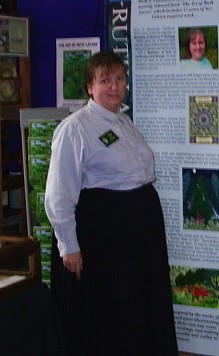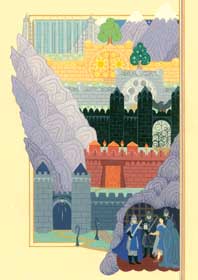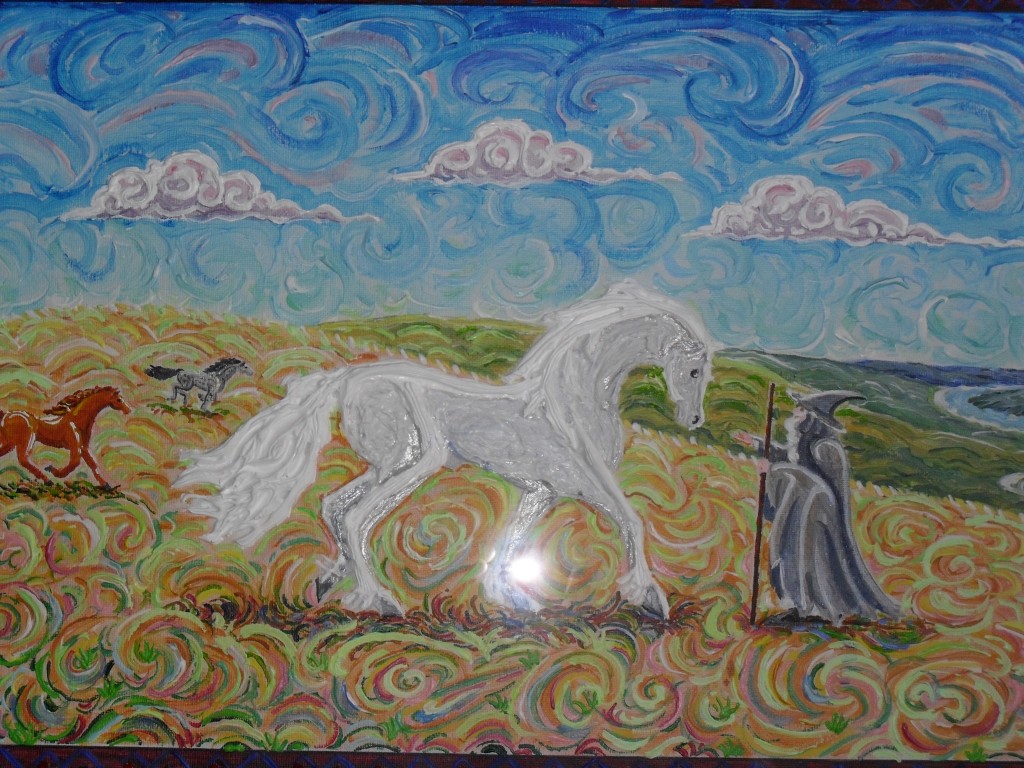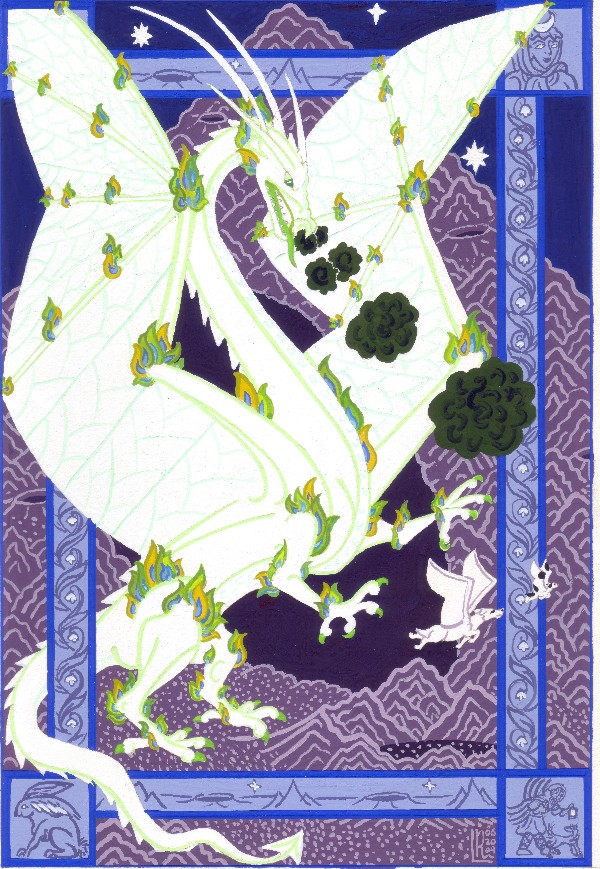 If there’s one thing I’ve learned about the universal Tolkien community, it’s that it is full of talented people! But if I’ve learned anything else, it’s that those talented people express their love of Tolkien’s writings in a variety of ways. I had the great pleasure of talking with artist Ruth Lacon about her artwork, and her approach to painting the Professor’s stories is unlike any I have seen.
If there’s one thing I’ve learned about the universal Tolkien community, it’s that it is full of talented people! But if I’ve learned anything else, it’s that those talented people express their love of Tolkien’s writings in a variety of ways. I had the great pleasure of talking with artist Ruth Lacon about her artwork, and her approach to painting the Professor’s stories is unlike any I have seen.
For starters, she loves The Silmarillion. “I’ll ‘fess up! I’m that rarest of objects, a Silmarillion freak,” Ruth announced. “I read the book when it first came out in paperback, when I was twelve, and I had two huge advantages. The first was simple – nobody told me it was a ‘difficult book.’ It’s amazing what you can get through if you think you can. The other was that ever since my storyteller grandfather died when I was eight, I’d been sneaking off with my Mum’s unused library tickets to get into the adult folklore section in our local library, looking for tales I’d heard alluded to, but which he’d never told me. After four years of truly awful Victorian and Edwardian folklore books, trust me, The Silmarillion was easy! And it had a ‘feel’ I recognised instantly – a sense of great age, of these stories only being summaries of something much bigger that might be out there if only.”
And while Ruth enjoys The Lord of the Rings and The Hobbit, she attests, “If you asked me for a dream project, it’d be an illustrated and illuminated version of The Silmarillion.”
Ruth was trained as a professional illustrator and holds a Bachelor of Arts degree in Illustration and Design. She explains that she works much like any other illustrator would. “Where it gets different is that I went into art school as a mature student who already had a wide-ranging knowledge and an appreciation of the sorts of art that would let me get down on paper what I had in my head,” she said. “I started out from a love of medieval art, and manuscripts in particular. I had the good fortune to actually get to look at a real 15th-century Book of Hours once, sneaking in to the Special Collections open day at Aberdeen University’s library when I should have been doing research for a science essay. It was a flashpoint moment of inspiration that’s never really left me.”
How she describes her style is fascinating. “I don’t work in a highly realistic style, and that’s a very deliberate choice. What we think of as ‘normal’ perspective and ‘realistic’ drawing are only two ways of turning the world into a flat image, out of many possibilities. I’m a lot more concerned with narrative, with composition, and with the emotional feel of a piece, than I am with ‘realism.’ So when I’m sketching a new piece, I’m thinking of it as flat pattern on the page as much as anything.
“I’ve done a picture of the Seven Gates of Gondolin, for instance, which is simply impossible to do in a realist style. There’s no position from which you can see everything that’s in that picture; you could only do it as an animation or a tracking shot. But by not being bound by those constraints, I could make an image that did incorporate everything. That used that information, to help the viewer follow the written story if it were in a book, to make an impressive image all by itself as a work of art.”
And it doesn’t stop there. When perusing her images, make sure to notice the borders. “It feels lazy to just slap a picture in and not think how it relates to its text and its reader,” she remarked. “It’s also a great way to sneak extra information in! Most of my borders are purely decorative, but you can use that area to add a huge density of material. I can indulge a love of pure colour and shape in those borders as nowhere else.”
I was surprised to discover that in addition to her illustrating background, Ruth also holds a degree in Zoology. She explained that it does very much affect the way she draws animals, plants, and mythical creatures. “First off, learning scientific drawing skills was great training in observing what’s there, which can be quite surprising,” she said. “My Ents, for example, are powerfully informed by sessions with a pad and pencil in front of our local oak trees. It’s only that discipline of looking and drawing that revealed the almost muscular flow of the bark, the sense that if this thing could move, boy would it be strong!
“The second point is that even though I don’t ‘do’ high realism, I will get it ‘right’ with animals. Painting Gandalf’s meeting with Shadowfax, Hasufel and Arod, for instance, I used real horse body-language to evoke the difference among the three of them, the trust between Gandalf and Shadowfax, the lightness and speed of Arod, and the heavier but willing Hasufel.
“Linked in to that is the obvious – what do you do with the likes of a dragon? Well, I’ve been working on those since I was drawing them on spare pages in my notepad during really boring Zoology lectures, doodling ideas based on what we’d learned about wing structure and use. I actually really enjoy using what I know to create a version of such a mythical creature which is plausible, which is aiming for the elegance and power of real predators, but is quite ‘other.’”
Ruth’s preferred medium is gouache. She revealed, “The reason was simple. It’s the closest modern equivalent to medieval tempera. It lets me achieve the sort of effects that I saw and admired. Its advantages for me are that you can be detailed and accurate, that being opaque you can ‘cut in’ easily with one colour over another, and the colour range and intensity are excellent. The ‘single cream’ working consistency feels lovely to me, on the right brush and paper – one of those little personal things that make a medium right for one person and wrong for others.”
Of course, she doesn’t just limit herself to painting; she is also a published author. “I’m right in the middle of a new book, actually, co-written as ever with my husband and longtime creative partner, Alex Lewis, on the influence of Tolkien’s Arthurian writing on The Lord of the Rings,” she said. “At the minute it’s the frustrating bit, sifting information out of a pile of books (an all-too-large pile that starts with the HoMe series and carries on through Sir Thomas Malory among others), and trying to figure out what happened. Hopefully we’ll soon be into full-blown writing, telling the story of what we’ve found out in a way that other people will with luck find interesting.”
And I just had to ask, as an expert on Tolkien, how does she feel about Peter Jackson’s adaptations of The Lord of the Rings (and imminently, The Hobbit) to the screen? “My position’s always been that anything that might get people to look at the books is good. Peter Jackson made choices about how to transfer The Lord of the Rings to film; I don’t always agree, but he was making those decisions under constraints which I don’t – indeed cannot – fully understand, so my criticism has to be muted. Overall, I think he did a pretty good job.
“As for The Hobbit – well, there’s an inevitable mismatch between a book written in the mid-1930’s for children, and a modern film for teens-to-adults. As long as it’s a good film, a worthwhile work of art in its own right which respects the wider ethos of Middle-earth rather than the letter of the text, I’ll be OK with it.”
For more of Ruth’s artwork, please visit FestivalArtandBooks.com or contact her agent Mark Faith.







8 Comments